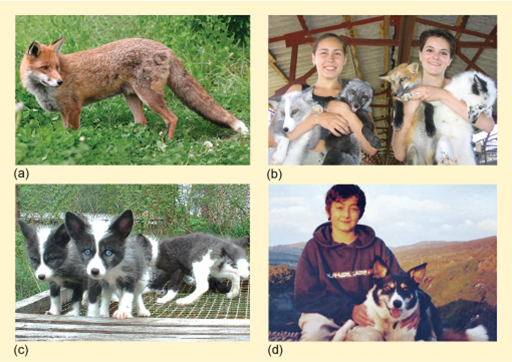1.6 Inheritance of temperament
Why do people have such different temperaments? Our early experiences may well make a significant contribution; however, genetic inheritance undoubtedly contributes to temperamental characteristics.
This is most clearly shown by experiments on animals. A fascinating experiment started in 1959 by the Russian geneticist Dmitri Belayev to tame captive-bred red foxes provides a good illustration of the fact that genetic inheritance affects temperament. In foxes, as in humans, there is variation in temperamental traits, with different individuals behaving differently. Most captive red foxes were either ferociously aggressive towards humans or afraid of them, but a small proportion showed neither of these traits – they showed the desirable trait of lack of fear and aggression towards humans.
In the experimental population, only those foxes that showed this desirable trait were selected for breeding. After repeating the process for 10 generations, 18% of the foxes in the experimental population were tame and happy to be with humans (Figure 5). They approached and licked people, wagged their tails, whined and begged for food. After 20 generations (40 years and 45 000 foxes later!), 35% were tame. The increasing proportion that exhibited the selected trait provided clear evidence that temperamental traits are heritable (Trut, 1999). The proportion showing the trait in the ‘control’ population remained low throughout the study.
Intriguingly, the genes mediating tameness also mediated a dramatic change in the appearance of the foxes. As Figure 5c shows, their coat colours and markings became very similar to those of domestic dogs such as border collies (Figure 5d). Genes affecting one character are often linked to genes affecting other characters, and can be passed on together – that is, genetic inheritance is complex in its effects.

You may feel surprised that, although Belayev and his colleagues bred only from foxes showing the ‘tameness’ trait, after 40 years only around one-third of the experimental population were ‘tame’. In fact, this is not really surprising as a trait of this kind is complex. It is linked to the activity not just of one gene but a whole constellation of genes. It is highly likely that many different genes contribute to the trait of ‘lack of fear and aggression towards humans’, and need to be inherited from its parents for an individual to manifest the trait. By analogy, getting one winning number on a lottery ticket is very common, but to win a substantial prize you need to get many or all numbers correct at the same time, and that is a much rarer occurrence.
